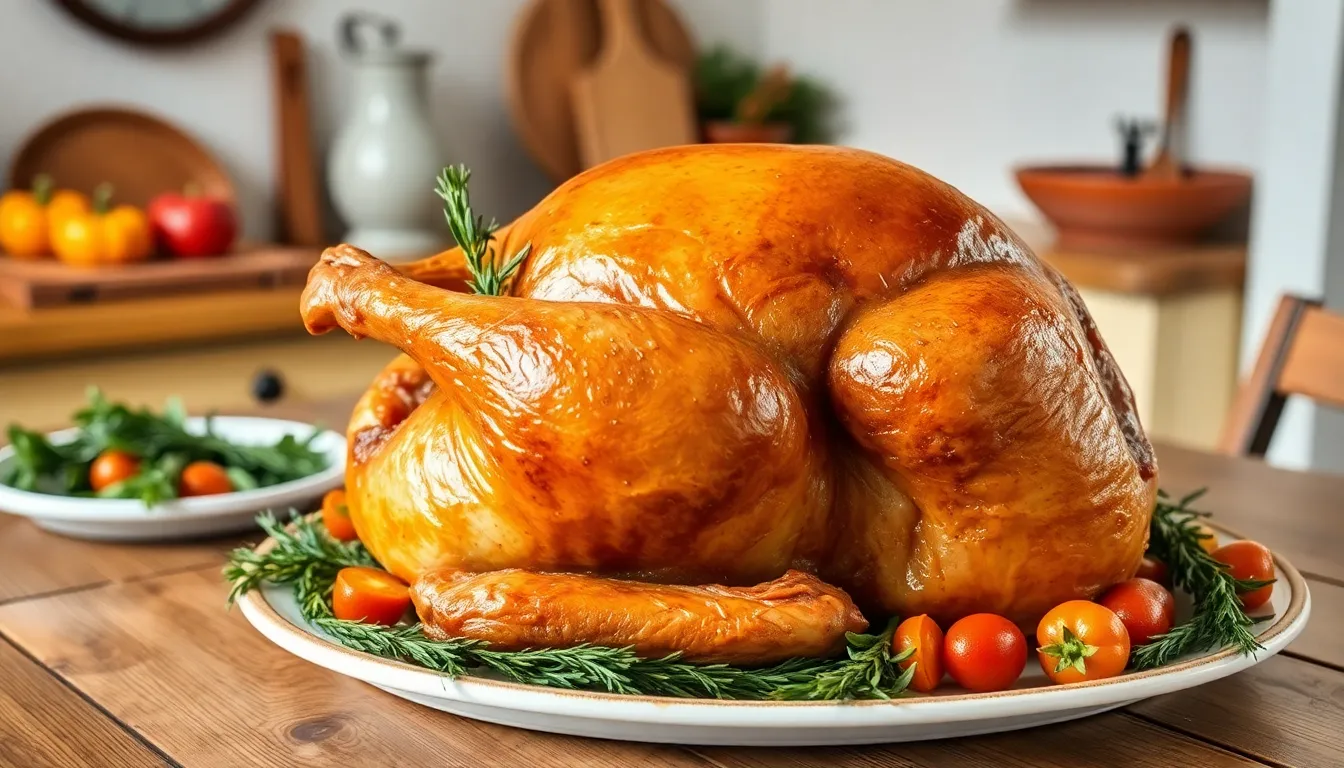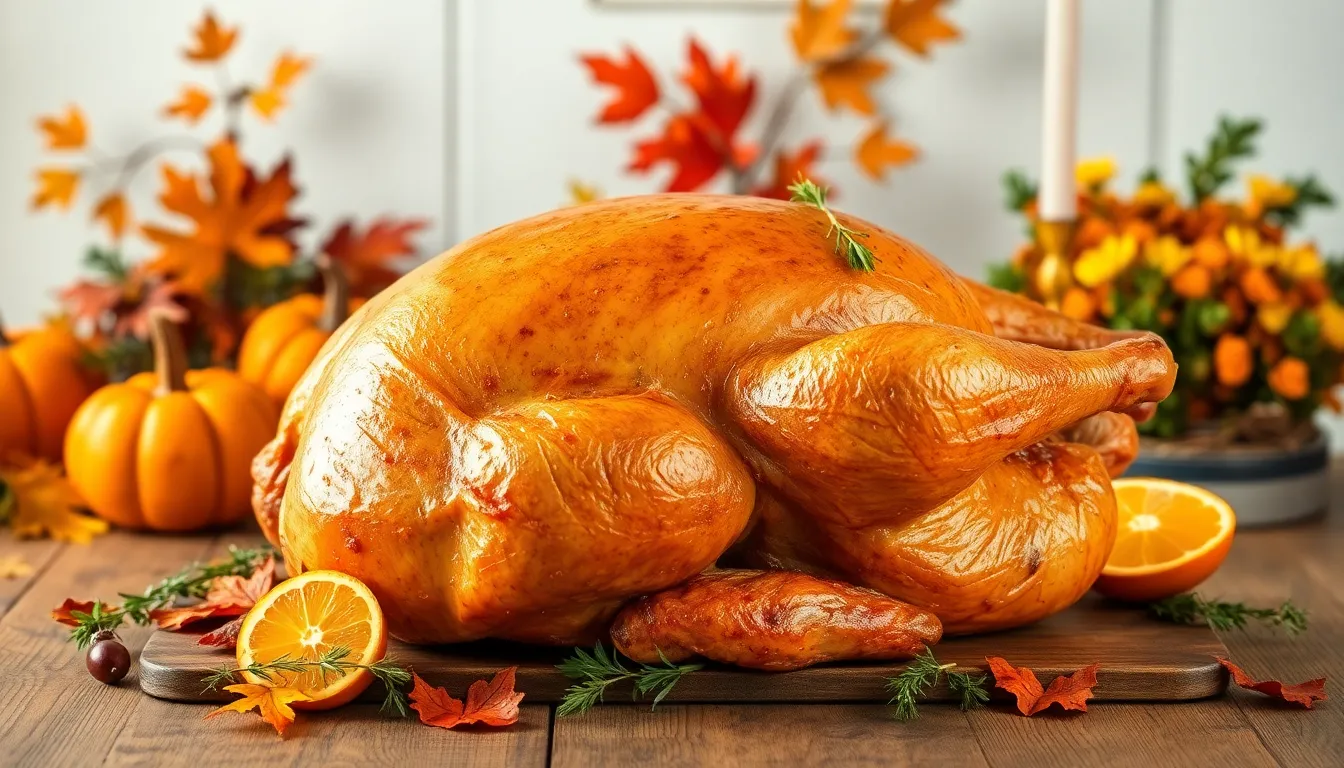Thanksgiving is just around the corner, and that means it’s time to tackle the ultimate culinary challenge: cooking a 15 lb turkey. Whether you’re a seasoned chef or a kitchen novice, the pressure is on to deliver a golden, juicy masterpiece that’ll leave your guests in awe—and maybe even a little envious. After all, no one wants to be “that” host whose turkey turns out drier than last year’s bread rolls.
Table of Contents
ToggleUnderstanding Turkey Cook Times
Cooking a 15 lb turkey requires attention to detail for optimal results. Various factors influence how long it takes to cook, impacting the final outcome.
Factors Affecting Cook Time
Turkey cook time hinges on multiple elements. The cooking method chosen plays a significant role, as different methods yield different results. An oven’s temperature affects cooking speed; a higher temperature cooks faster but can lead to dryness. Additionally, turkey shape and size create variations. A stuffed turkey typically requires more time than an unstuffed one due to internal heat distribution. Finally, turkey quality and freshness can also alter cook times. A frozen turkey requires a longer thawing and cooking period compared to a fresh one.
Cooking Methods Overview
Multiple cooking methods can prepare a turkey effectively. Roasting remains the most common approach, yielding juicy and evenly cooked meat. This method typically requires about 13 to 15 minutes per pound at 325°F. Frying serves as a faster alternative; expect a time of about 3 to 4 minutes per pound. Grilling adds a smoky flavor and takes roughly 11 to 13 minutes per pound at a consistent temperature. Slow-cooking offers convenience but needs about 6 to 8 hours on low for comprehensive results. Each method provides unique benefits, making it essential to choose based on preferences and desired outcomes.
Recommended Cook Times for a 15 lb Turkey

Cook times for a 15 lb turkey vary based on the cooking method. Precision in following guidelines ensures a juicy and flavorful outcome.
Roasting
Roasting a 15 lb turkey typically takes 3 to 4 hours at an oven temperature of 325°F. For optimal results, ensure that the turkey’s internal temperature reaches 165°F in the thickest part of the breast and thigh. Using a meat thermometer helps achieve this goal. For a well-browned skin, consider covering the bird with foil during the first half of cooking, then removing it during the final hour. Basting the turkey occasionally enhances moisture and flavor as well.
Grilling
Grilling a 15 lb turkey can produce a delicious smoky flavor. The cooking time averages 2 to 2.5 hours over medium heat. It’s important to maintain a grill temperature of 350°F to 375°F. For even cooking, the turkey should be turned every 30 minutes. Using a drip pan beneath the turkey collects juices, preventing flare-ups and keeping the grill clean. Ensure it reaches an internal temperature of 165°F for safety and optimal taste.
Frying
Frying a 15 lb turkey requires about 3 to 4 minutes per pound in hot oil, resulting in a total cooking time of approximately 45 to 60 minutes. Maintaining an oil temperature of 350°F is crucial for crispy skin. Care must be taken when lowering the turkey into the oil to prevent splatter. A thermometer can help monitor the internal temperature, ensuring it reaches 165°F. Resting the turkey for at least 20 minutes after frying allows juices to redistribute, enhancing the flavor profile.
Preparing Your 15 lb Turkey
Proper preparation is key to achieving a tender and juicy turkey. Various steps ensure the best possible flavor and texture.
Thawing Tips
Thawing a 15 lb turkey safely is crucial for optimal cooking results. Plan ahead; the turkey requires approximately 24 hours of thawing time for every 4 to 5 pounds in the refrigerator. This means a full 15 lb turkey needs about three days in the fridge. Alternatively, cold water thawing speeds things up. Submerge the turkey in water and change the water every 30 minutes, allowing about 30 minutes of thawing time per pound. For a 15 lb turkey, this method takes approximately 7 to 8 hours. Always ensure the turkey remains in its original packaging during the thawing process.
Seasoning and Stuffing
Seasoning enhances the flavor of a turkey significantly. Apply a generous amount of salt and pepper both inside and outside the bird. Some cooks prefer additional seasonings like garlic powder, thyme, or rosemary for more flavor. Stuffing the turkey is optional; if chosen, ensure the stuffing reaches an internal temperature of 165°F for safety. Fill the cavity loosely to allow for even cooking. If opting for a herb butter mixture, consider spreading it under the skin to maximize moisture retention and flavor. Lastly, let the turkey rest for 30 minutes after seasoning to develop the flavors fully.
Monitoring Turkey Doneness
Monitoring turkey doneness ensures a perfectly cooked bird for any gathering. Accurate measurements prevent serving undercooked or dry turkey.
Recommended Internal Temperatures
The USDA recommends specific internal temperatures for turkey to ensure safety. A whole turkey requires a minimum internal temperature of 165°F. The breast meat, dark meat, and stuffing all should reach this temperature. Optimal flavor occurs when the breast registers about 165°F, while dark meat might reach between 175°F and 180°F for tenderness.
Tools for Checking Doneness
Using a meat thermometer provides the most reliable way to check turkey doneness. A digital instant-read thermometer delivers quick results, allowing for accurate checks. Inserting the thermometer into the thickest part of the breast without touching the bone guarantees an accurate reading. Another reliable option is a leave-in probe thermometer, which monitors the temperature throughout the cooking process. These tools help achieve the perfect juicy turkey while ensuring food safety.
Cooking a 15 lb turkey doesn’t have to be a daunting task. With the right preparation and knowledge of cook times, anyone can create a delicious centerpiece for their holiday table. It’s essential to choose a cooking method that suits personal preferences while keeping an eye on internal temperatures for safety and quality.
By allowing the turkey to rest and properly seasoning it, the final result can be both tender and flavorful. With these tips in mind, anyone can confidently tackle their turkey this Thanksgiving, ensuring a memorable meal that will impress family and friends alike.


